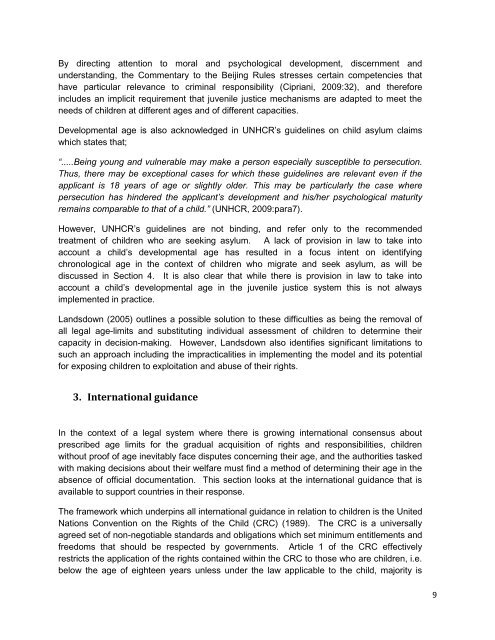Age assessment practices: a literature review & annotated ... - Unicef
Age assessment practices: a literature review & annotated ... - Unicef
Age assessment practices: a literature review & annotated ... - Unicef
Create successful ePaper yourself
Turn your PDF publications into a flip-book with our unique Google optimized e-Paper software.
By directing attention to moral and psychological development, discernment and<br />
understanding, the Commentary to the Beijing Rules stresses certain competencies that<br />
have particular relevance to criminal responsibility (Cipriani, 2009:32), and therefore<br />
includes an implicit requirement that juvenile justice mechanisms are adapted to meet the<br />
needs of children at different ages and of different capacities.<br />
Developmental age is also acknowledged in UNHCR‟s guidelines on child asylum claims<br />
which states that;<br />
“.....Being young and vulnerable may make a person especially susceptible to persecution.<br />
Thus, there may be exceptional cases for which these guidelines are relevant even if the<br />
applicant is 18 years of age or slightly older. This may be particularly the case where<br />
persecution has hindered the applicant‟s development and his/her psychological maturity<br />
remains comparable to that of a child.” (UNHCR, 2009:para7).<br />
However, UNHCR‟s guidelines are not binding, and refer only to the recommended<br />
treatment of children who are seeking asylum. A lack of provision in law to take into<br />
account a child‟s developmental age has resulted in a focus intent on identifying<br />
chronological age in the context of children who migrate and seek asylum, as will be<br />
discussed in Section 4. It is also clear that while there is provision in law to take into<br />
account a child‟s developmental age in the juvenile justice system this is not always<br />
implemented in practice.<br />
Landsdown (2005) outlines a possible solution to these difficulties as being the removal of<br />
all legal age-limits and substituting individual <strong>assessment</strong> of children to determine their<br />
capacity in decision-making. However, Landsdown also identifies significant limitations to<br />
such an approach including the impracticalities in implementing the model and its potential<br />
for exposing children to exploitation and abuse of their rights.<br />
3. International guidance<br />
In the context of a legal system where there is growing international consensus about<br />
prescribed age limits for the gradual acquisition of rights and responsibilities, children<br />
without proof of age inevitably face disputes concerning their age, and the authorities tasked<br />
with making decisions about their welfare must find a method of determining their age in the<br />
absence of official documentation. This section looks at the international guidance that is<br />
available to support countries in their response.<br />
The framework which underpins all international guidance in relation to children is the United<br />
Nations Convention on the Rights of the Child (CRC) (1989). The CRC is a universally<br />
agreed set of non-negotiable standards and obligations which set minimum entitlements and<br />
freedoms that should be respected by governments. Article 1 of the CRC effectively<br />
restricts the application of the rights contained within the CRC to those who are children, i.e.<br />
below the age of eighteen years unless under the law applicable to the child, majority is<br />
9
















